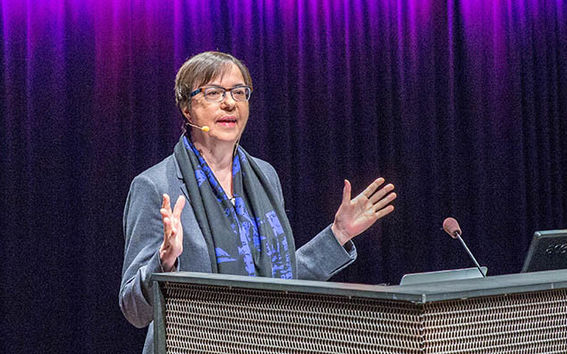From IDBM club to a collective of multi-talented people

The International Design Business Management (IDBM) programme is a multidisciplinary programme jointly arranged by the Aalto University schools. The programme was established in 1995, and from the very start its multidisciplinary research and learning has focused on using design and technology to develop global business. The aim is to educate innovation producers and leaders for the development of new products, services and business.
Architect and Doctor of Science (Technology) Anne Stenros took over as IDBM Program Director at the beginning of this year.
"I moved from real life to preparatory life. I felt that design had already been internalised at my previous workplace at KONE. As I recognise a part of me that seeks challenges from working life, I decided that after 10 years at KONE it was time to learn something new again. I have always been very learning-oriented," says Anne Stenros as she explains her move from business life to Aalto University.
Of course, Stenros has also been active outside business circles in recent years, for example, in the EU.
"I was an individual expert in the RISE – Research, Innovation and Science Policy Experts group and was also involved in several RIF – Research and Innovation Futures workshops and expert bodies. I also took part in a small working group that developed the EU Horizon 2020 programme, which funds European research and innovation projects. Most recently, I chaired a working group that developed 'The European Capital of Innovation Award – iCapital', which will be presented for the second time this spring."
According to Anne Stenros, Europe and Finland have fallen far behind the pace of international development in design thinking. She believes that we still don't really understand how important a role design plays in strategic business development. There has been a lack of interest on the part of industry and companies in this area. During the past three years, management teams in other parts of the world have made design a major part of their agenda. Several leading companies in the USA have already hired a Chief Design Officer (CDO).
IBM is an outstanding example of broad-based strategic utilisation of design. They have always understood that design is one of the strategic core functions of a company. They began by designing products then moved on to interfaces and services and now business functions. World-famous graphic designer Paul Rand (1914–1996), who once worked for IBM, was a pioneer in terms of understanding comprehensive design thinking. Rand began working for IBM in the 1950s. Today, IBM has several design agencies around the world and its goal is to employ more than 1 000 designers. Furthermore, the company's entire management is trained in creative problem-solving and understanding the strategic importance of design. Strategic use of design provides three clear competitive edges: a user-centred product and service focus, forecasting and understanding the future, and an empathic customer and corporate culture.
Design is an immense resource for creative problem-solving
"I hope that the IDBM programme will be open to even more students in the future. Earlier, it was a bit like a club, but now I want it to become more of a collective for multi-talented people. The more people understand what design thinking is about, the better. We have always had a high-quality student body and the students are linked by a genuine interest in applying design thinking. Creativity, solving complex problems and critical thinking are some of the most important skills for future employees, and these qualities are at the heart of design thinking learning. IDBM also teaches team work skills very well. I try to get young people to understand what a great resource design is in terms of all types of creative problem solving," says Stenros as she describes her goals as IDBM Program Director.
"In the future, the curriculum will have a greater focus on design strategy, and design students also need more basic studies in business. A good general education helps with everything, and this is also the case in multidisciplinary group assignments. It's important to recognise which skills will be needed in working life in 10 years, and this is what we are trying to assess in the content workshops being held during the spring. I'm delighted that design thinking is also at the core of Aalto's new strategy, and it's our job to consider how we can build IDBM according to the strategy," says Stenros.
It's impossible to interview Anne Stenros without talking a bit about the Women in Tech network that she and some colleagues founded a few years ago. Its primary target is to encourage more young women to study mathematics and technology and work for companies in the industry. Networking across boundaries allows women to jointly increase their influence. The Federation of Finnish Technology Industries coordinates activities in cooperation with member companies and other partners. Women in Tech will be involved in celebrating the 100th anniversary of Finnish independence with a jubilee forum scheduled for October 2017.
Further information:
idbm.aalto.fi
The IDBM programme can be completed as a two-year full-time master's programme or as a minor over a period of two years. At the core of the program is the Industry Project, lasting a full academic year, where multidisciplinary student teams do project work for an industrial company. The studies include courses on design and creativity management, business model development, innovation management, and design business development and management. At this time, 45 students are taking the IDBM programme, including 15 business students, 15 technology students and 15 arts students as well as minor students. The application period for minor studies in the IDBM programme ends on 15 May.
- Published:
- Updated:
Read more news

Online AI course could boost study equality
Students at the School of Business believe that mastering Artificial Intelligence (AI) can be beneficial for both academic success and career prospects, as AI becomes increasingly integrated into daily life.
2 027 new students admitted to Aalto University’s Finnish, Swedish bachelor’s programmes
13 500 applied to Aalto University in Finland's spring joint application in 2024
Meet the the Program Assistants that elevate the Aalto University Summer School experience for 250 students from all over the world
Each year, the Aalto University Summer School has grown its operations and course curriculum tremendously.